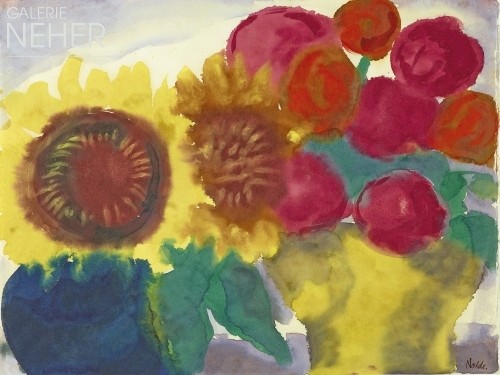Emil Nolde
* 07 08 1867 | Nolde
† 13 04 1956 | Seebüll
The explosively colourful Expressionist is one of the most well-known German artists of the 20th century. Emil Nolde’s diverse artistic oeuvre, especially the brilliant watercolours, captivates with impressive images of human beings and religious subjects, as well as with landscapes and floral still lifes in radiant colouring.
Works by Emil Nolde
Vita Emil Nolde
1867
Born on 7 August as Emil Hansen in Nolde near Tondern.
1884–88
Apprenticeship as a wood sculptor and draughtsman in a Flensburg furniture factory.
1888–91
Journeyman years. Work as a carver in furniture factories in Munich and Karlsruhe, where he also attends the school of arts and crafts.
1890
Employment in a Berlin furniture factory.
1892–97
He becomes a specialist teacher for industrial drawing and modelling at the Industry and Commerce Museum St. Gallen.
First drawings and landscape watercolours.
1898–01
Hansen attends the private painting schools of Friedrich Fehr and Adolf Hölzel. Stays and studies in Munich, Dachau, Paris and Copenhagen.
1899
Attends the private Académie Julian in Paris.
1900
He rents a studio in Copenhagen and paints an early series of religious paintings.
1901
Hansen spends the summer in the fishing village Lild Strand on the north coast of Jutland.
1902
Marriage to the Danish actress Ada Vilstrup, accompanied by the change of his birth name to Emil Nolde. Move from Copenhagen to Berlin.
1903–05
The couple spends the winter in Berlin, the summer on the island of Alsen.
1904/05
Friends make it possible for the couple to stay in Italy for six months.
1905
First Berlin exhibition in the art salon of Paul Cassirer.
1906/07
Membership in the Die Brücke artist group, which had been founded by Ernst Ludwig Kirchner, Erich Heckel, Karl-Schmidt-Rottluff and Fritz Bleyl in 1905.
1908
Member of the Berlin Secession. A trip to Sweden in autumn.
1910
Larger exhibitions of his work in Hamburg, Essen, Jena and Hagen.
Exclusion from the Berlin Secession following a dispute with Max Liebermann.
1911
The Hamburg art collector Gustav Schiefler publishes the first volume of the catalogue raisonné of prints.
Studies in the Berlin museum of ethnology.
1913/14
The couple participates in a research expedition and travels to German New Guinea via Moscow, Siberia, Korea, Japan and China. Here, Nolde paints colourful paintings of the sea and vegetation, exotic plants and animals, as well as portraits of the inhabitants.
The return journey takes place following the outbreak of the war after August 1914 and leads the artist and his wife from the Suez Canal through France and Switzerland back to Germany. His South Seas works are confiscated at the Suez Canal. He only takes possession of them again in 1921 in Plymouth.
The artist later describes his South Seas travels in an autobiographical volume with the title Welt und Heimat [World and homeland] (1936/65).
1916–26
Summer stays in the Utenwarf farmhouse close to the North Sea coast.
1919
He becomes a member in the Berlin Arbeitsrat für Kunst (Workers’ council for art).
1920
Nolde takes on Danish citizenship.
1921
Max Sauerlandt publishes a first monograph.
Travel to London, Plymouth, Paris, Toulouse, Barcelona, Granada, Madrid and Toledo.
1924
Travel to Venice, Florence, Zurich and Vienna.
1927
Move to Seebüll. Building of a home and studio house and planting of a luxuriant flower garden.
On the occasion of his 60th birthday, anniversary exhibitions in Dresden, Hamburg, Kiel, Essen and Wiesbaden. Awarded an honorary doctorate by the University of Kiel.
Gustav Schiefler publishes the second volume of the catalogue raisonné of prints.
1931
Call to the Prussian Academy of Arts.
Publication of the first volume of his autobiography under the title Das eigene Leben (My own life).
1933
Following the government takeover of the National Socialists, Nolde hopes to be named as a Staatskünstler (state artist).
1934
Exhibition of his watercolours in the Galerie Möller in Berlin, and subsequently in Düren, Hamburg and Hannover.
Signs the “Aufruf der Kulturschaffenden” (Call to the cultural sector). He becomes a member of the National Socialist Council of North Schleswig (NSAN) as a Danish citizen.
The second volume of his autobiography appears in November under the title Jahre der Kämpfe (Years of struggle).
1935/36
The museum association of the Museum Folkwang in Essen purchases almost all of his graphic works, around 450 sheets.
In December 1935, a stomach cancer operation in Hamburg, followed by stationary treatment until March 1936 and a recuperation journey to Switzerland.
1937/38
Around a thousand of Nolde’s works are confiscated from German museums, also including the sheets from the Museum Folkwang. 33 of his works are included in the defamatory National Socialist Degenerate Art exhibition.
Exhibitions in the galleries Günther Franke in Munich, Ferdinand Möller in Berlin and Rudolf Probst in Mannheim on the occasion of his 70th birthday.
1939
Nolde places 91 paintings in storage on a farm at the mouth of the Elbe following the start of the Second World War.
1940
Nolde spends part of the winter in Seebüll with his wife to escape the air attacks.
1941
Expulsion from the Reich Chamber of Fine Arts and prohibition from painting. Nolde is still able to continually work creatively in remote Seebüll despite the professional prohibition and the scarcity of materials.
1944
His Berlin studio apartment is destroyed by bombing in February. The artist loses around 3,000 graphic works, watercolours and drawings.
1946
Exoneration by the denazification committee.
Ada Nolde dies on 2 November.
1948
Marriage with the 26-year-old Jolanthe Erdmann, daughter of his friend, the composer and pianist Eduard Erdmann.
1950
He is awarded the prize of the XXV Biennale di Venezia for his graphic work.
1951
Nolde no longer paints oil paintings after breaking his left upper arm.
1956
Nolde dies on 13 April in Seebüll.
Only slightly later, on 12 June, the Seebüll Foundation Ada and Emil Nolde is recognised as a legally valid foundation under civil law.
